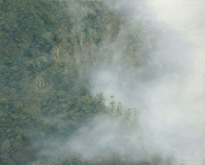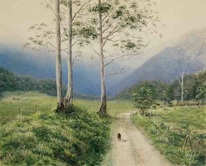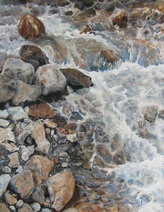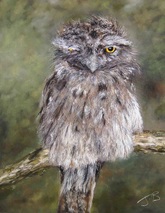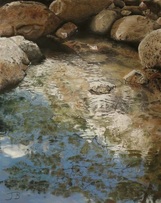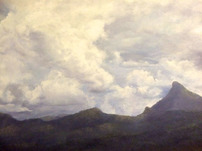The Art of Jan Bracher
Tyalgum
|
Hoop Pines in the Mist
NFS Hoop Pines, Araucaria cunninghamii, along with a myriad of other plant species, can be seen on the edge of a precipitous slope within the Border Ranges National Park. Being a large native coniferous tree, it has an important role in rainforest ecosystems by hosting a variety of flora and fauna. Historically, extensive logging depleted most natural stands, however the species continues to thrive in protected areas in Australia's Green Cauldron. As I sit on my patio at home, I can look up into the mist covered rainforests and see these magnificent trees. I also hope that humans worldwide can balance their demands upon forests by regenerating depleted areas. < Back |
|
Afternoon Walk
NFS The caldera region is one of great natural beauty and, from an artist's perspective, totally inspirational. The varied shapes and textures of the forested escarpments are often brightly illuminated by plays of sunlight producing dramatic effects. These are are sometimes subdued by the rolling mists during the wet season. The adjoining farmlands and rolling hills create forest edges which are so important for wildlife. As I walk with my dogs late one summer’s afternoon, I reflect upon this scene and am grateful to be part of it. With gratitude I feel connected to this landscape and am motivated to promoting its conservation. < Back |
|
River Life
NFS The Oxley River is formed by the confluence of a number of small un-named creeks arising on the southern slopes of the McPherson Range, near Tyalgum. As a river, it reaches its confluence with the Tweed River near Murwillumbah. It is an example of a localised ecosystem, involving biotic (living) interactions as well as abiotic (nonliving) physical and chemical interactions, with good water flow being the key to maintaining a healthy ecosystem through oxygenation. I enjoyed painting the shape of the stream-bed with worn and shaped rocks, some rounded, some sharp, some large, some small, and some with evidence of cracks. It is a vital ecosystem within the Tweed Valley. < Back |
|
Tawny Frogmouth with Attitude
NFS These nocturnal birds are not owls but are related to nightjars. The Tawny Frogmouth has been called a bio-sentinel species since it serves as a barometer of environmental health. It has adapted well to human habitation but seems to be paying a very high price for that adaptation by a high mortality rate in urban areas. They are often killed or injured on the roads as they fly down to seize moths attracted by streetlights. Fortunately, they remain abundant throughout their range including in the caldera area. This particular individual was 'caught' napping during the day and expressed a degree of 'attitude' which I endeavored to convey in my painting. < back |
|
Textures of Nature
NFS The Oxley River is formed by the confluence of a number of small creeks including this un-named one. It arises on the southern slopes of the McPherson Range near Tyalgum and, as a river, merges with the Tweed River near Murwillumbah. It is an example of a localised ecosystem, involving biotic (living) interactions as well as abiotic (nonliving) physical and chemical interactions. The surrounding trees are reflected in the water along with rocks worn smooth and randomly shaped by erosion forces. 'River Life' was painted at this same location with the stream in a state of turbulence. This year it is at peace. < back |
|
Wollumbin Cloudscape
NFS Mt Warning / Wollumbin, seen here as a distant peak within a ‘cloudscape’ (which suggests an impending summer storm), has a haunting and inescapable presence within the Tweed Valley. The summit is often girt by cloud with the average yearly rainfall in a nearby area (Tyalgum) being over 1600 mm. This rain is integral to supporting the remarkable biodiversity of the area. The region known as Australia's Green Cauldron has one of the highest number of flora and fauna species in Australia. This was my first journey into the use of oils as a painting medium. < back |
|
Jan Bracher
I witness the beauty of the Tweed Caldera virtually every day. Driving or walking through the landscape I see the interplay of forests, rivers, fields, wildlife and the weather. This inspires me to paint wildscapes with as much detail and realism as possible. I try to pay my respects to the marvelous chaos of colours, shapes and textures of Nature. Soft pastels and oils are my preferred mediums. It was only after moving here 8 years ago that I started painting. Caldera Art has been my creative home, and with direction from Tutor Andy Reimanis and inspiration from fellow artists, the few hours I spend painting each week in the gallery offers quietness, introspection and connection. This creates a balance in an otherwise very hectic and demanding work life. I am deeply grateful for this. < back Contact Jan |

